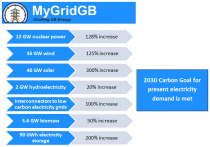The MyGridGB Manifesto proposes one way that Britain can meet its present electricity demands using low carbon electricity. I first proposed it in July 2016 and since then it has been simulated, in real time, on the MyGridGB website. In this blog, we explore the manifesto and how it is structured. After reading it, I invite you to comment and look at ways that the manifesto might be changed in the future.
The MyGridGB Manifesto proposes one way that Britain can meet its present electricity demands using low carbon electricity. I first proposed it in July 2016 and since then it has been simulated, in real time, on the MyGridGB website. In this blog, we explore the manifesto and how it is structured. After reading it, I invite you to comment and look at ways that the manifesto might be changed in the future.
One thing is very clear, the manifesto shows that low carbon electricity is possible despite the intermittency of wind and solar power. What people may disagree on is the exact mix that I propose- or what extra demand for low carbon heat and transport will do for our electricity demand.
The Manifesto is based on some simple principles:
- A modest increase in wind and solar power. These are continuing to fall in price, with both at our below present electricity prices and certainly cheaper than nuclear power.
- Investment in new nuclear power stations to provide baseload generation of low-carbon electricity.
- No coal generation and switching from relying on gas generation to provide baseload power, to using gas power stations to provide electricity when there is no sun or wind.
The use of nuclear power will be controversial to some. The price of electricity from the new power station at Hinkley C is far higher than what we pay now and the long term environmental concerns around Nuclear waste are not to be ignored. I continue to explore low-carbon alternatives such as marine (tidal/wave) power for future manifestos.
To simulate the manifesto, I use the same data which drives the MyGridGB electricity graphs. Below is the electricity supply for the first full week of February 2017 as was.
[visualizer id=”803″]
Over the 7 days shown, 61% of electricity was from fossil fuels and released more than 2.3 million tonnes of greenhouse gas (measured as CO2 equivalent). Had the manifesto been implemented, the same electricity demand would have been met as follows:
[visualizer id=”804″]
Here, fossil fuel use falls from 61% of energy to 20%. Finite and high carbon sources are being saved for when they are most needed. Solar and wind provide 25% of our electricity and it is noted that, even in winter solar makes a noticeable contribution. In the summer, I will revisit this blog and look at the contribution solar and wind make then.
Imports of low carbon electricity are used when there is a shortfall of wind or solar. Imports in my manifesto only come from countries with low carbon generation such as Norway, France or Iceland. Energy storage also plays a role in taking excess solar and wind and deploying it when needed.
The manifesto relies on a doubling of Nuclear power to provide a baseload of low-carbon electricity. France generates more than 80% of her electricity from nuclear power plants. This scenario needs just 38%.
The resulting carbon emissions are impressive. Carbon emissions fall from 388 gCO2/kWh to just 88 gCO2/kWh. The Committee on Climate Change 2030 target is 50-100 gCO2/kWh. In a cold February week, the Manifesto meets the emissions goals.
[visualizer id=”808″]
The MyGridGB Manifesto has taught me that low-carbon electricity is possible and that supporting low-carbon technology will make British electricity fit for the future. The manifesto is open for debate. Imagine this with tidal power or more efficient use of electricity.
However, there are some headwinds to be aware of. Decarbonising heating and transport using electricity will dramatically increase demand and need a whole extra means of generating energy. That is the subject of future blogs and I have some exciting bloggers lined up to help tell that story.

